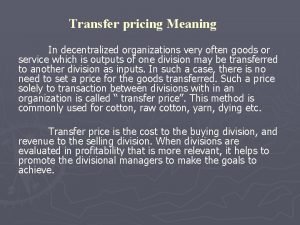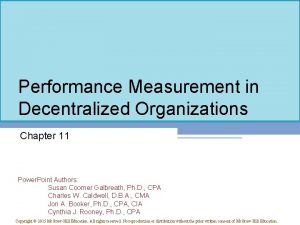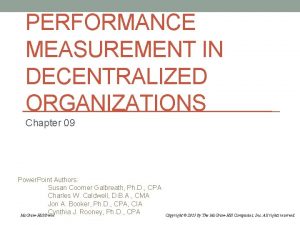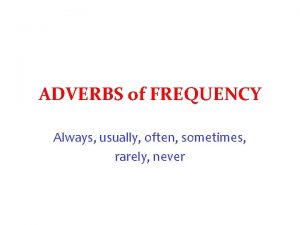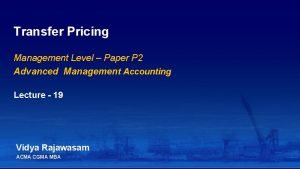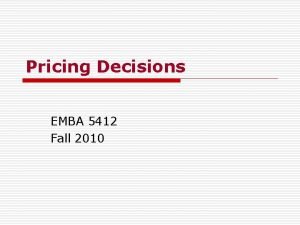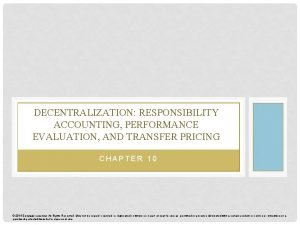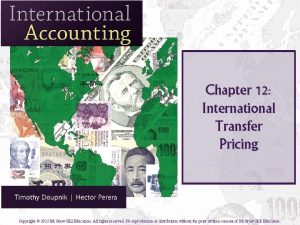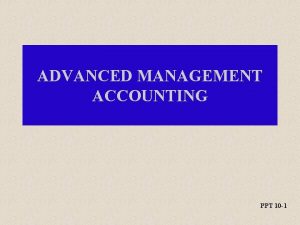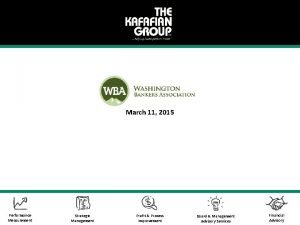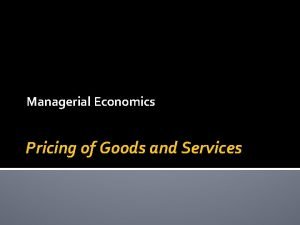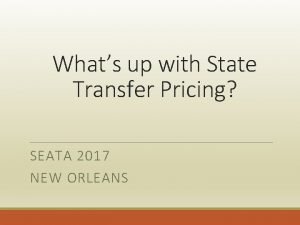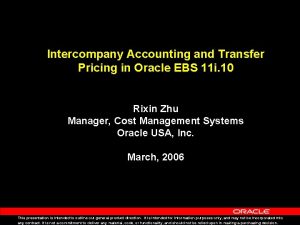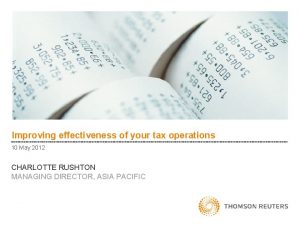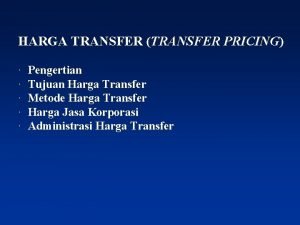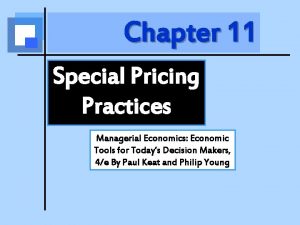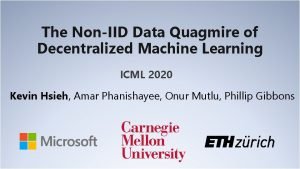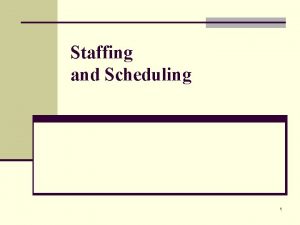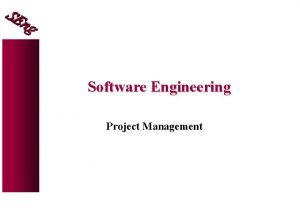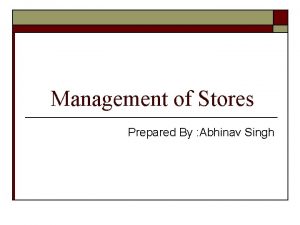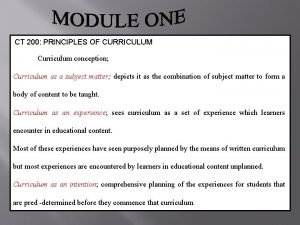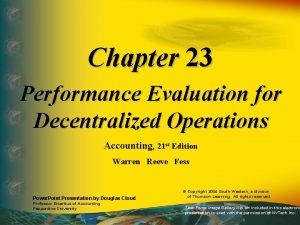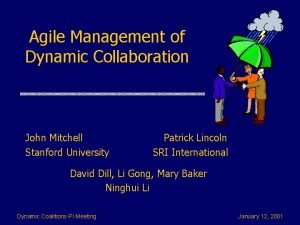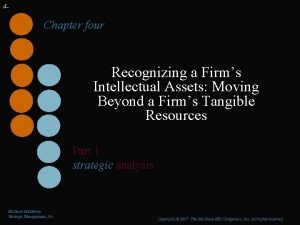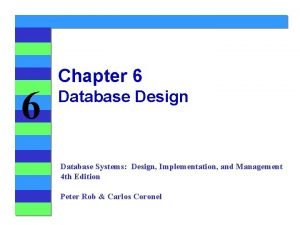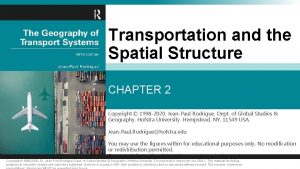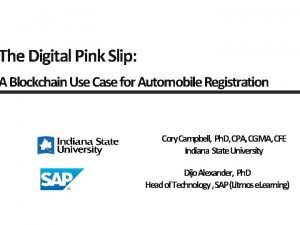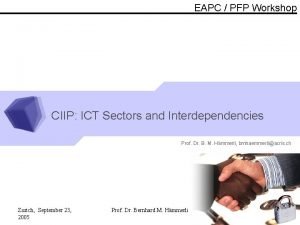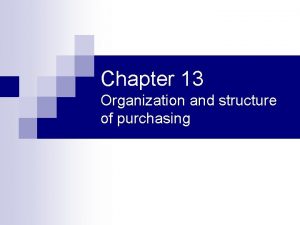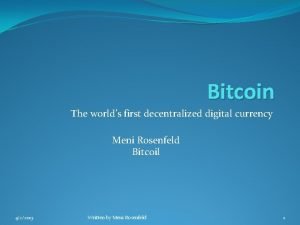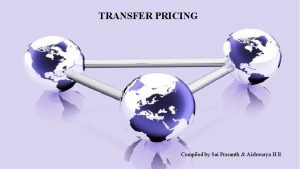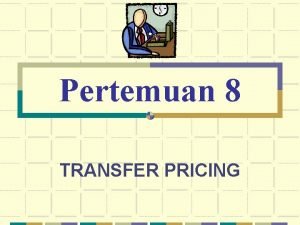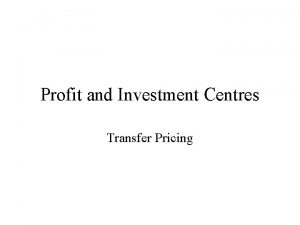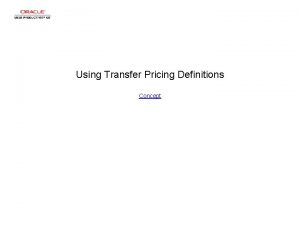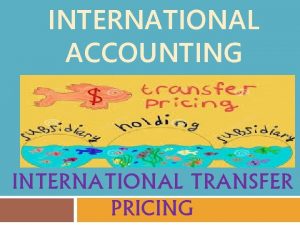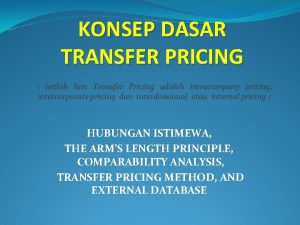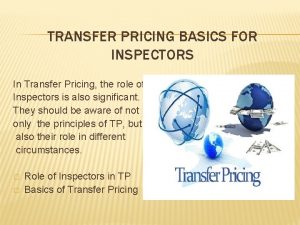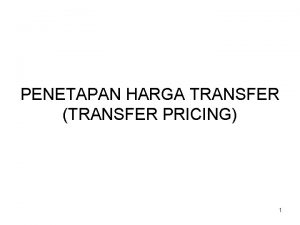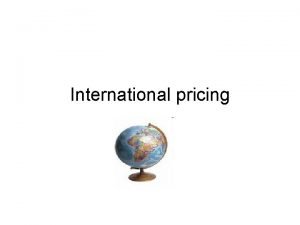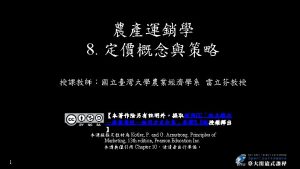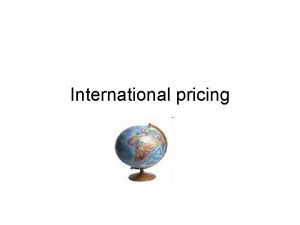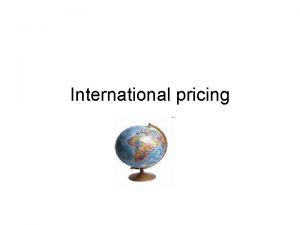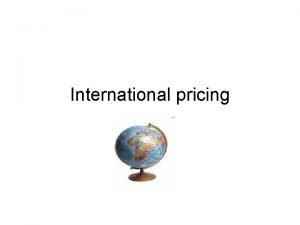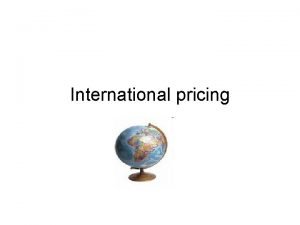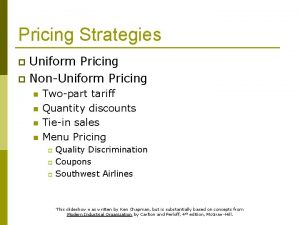Transfer pricing Meaning In decentralized organizations very often















































- Slides: 47

Transfer pricing Meaning In decentralized organizations very often goods or service which is outputs of one division may be transferred to another division as inputs. In such a case, there is no need to set a price for the goods transferred. Such a price solely to transaction between divisions with in an organization is called “ transfer price”. This method is commonly used for cotton, raw cotton, yarn, dying etc. Transfer price is the cost to the buying division, and revenue to the selling division. When divisions are evaluated in profitability that is more relevant, it helps to promote the divisional managers to make the goals to achieve.

The transfer price arises when goods transfer from one department to other with in a concern of goods or service or products. In each department there is a separate manager who has all adequate authority and to make decision about the buying and selling and the investments that are to be made and how to make profit.

OBJECTIVES ► ► • • To measure the performance of the department To make the department a competitive one To make profit from each production unit and to maximize its product To involve in the making process Make the investment in profit which can be realistic to cost To make decisions for buying selling and all other activities and process

METHODS OF TRANSFER PRICING 1. Total cost method : It covers all the cost that occurs for production that may be actual cost or standard cost. It is based on only the cost that is made for the production of the goods. 2. Total cost plus profit method : A suitable percentage of profit will be added to the cost that is occurred while production and the transfer price will be set with some percentage of profit. This may be total cost, actual cost or transfer cost, it is used where the same product and services are not available in the market.

3. Marginal cost method: When the internal price is high when compared with the market price. In the case the internal price will be used as a transfer price. In this method, the company will be motivated to use the internally produced goods. 4. Market price method : If transfer is made at market price and if really market is available for product most it is widely used.

PROBLEMS 1. Division A for a manufacturing company has set target sales of 4, 000 units of a product at a price fetch a return of 25% on the assets employed. The following data are available. Fixed costs Variable costs Assets employed: Fixed assets Current assets Rs 8, 000 Rs 1 per unit Rs. 8, 000 Rs. 16, 000

The market can however absorb only 2. 80, 000 units. Consequently, division B is advised to buy 1, 20, 000 units. Division A willing to supply this quantity to division B, however want it at Rs 2. 25 per unit. If A refuses to supply its requirement of 1, 20, 000 units at Rs. 2, 25 per unit and Restricted, its activity to 2, 80, 000 units of market sale, it could reduce the investment in stock to the tune of rs. 160000 and he fixed assets by Rs 2, 40, 000. Besides it selling expenses will also go down by Rs. 80, 000. You are required to prepare statement and advise whether A should agree to supply B’ requirement at 1, 20, 000 units at Rs. 2. 25 per unit.

SOLUTION Return @ 25% on total assets 6, 000 Employed rs. 24, 000 Fixed cost 8, 000 Variable cost 4, 000 x 1 4, 000 Total 18, 000 Selling price per unit = 18, 000 / 4, 000 = Rs. 4. 50 Results of two levels of output. Particulars Sales 4, 000 units 2, 80, 000*4. 5 p/u 1, 20, 000*2. 25 p/u 2, 80, 000 units 12, 60, 000 2, 70, 000 12, 60, 000 ------

Total (A) Variable cost Fixed cost Total (B Profit (A-B) Assets employed Rs. 15, 30, 000 4, 000 8, 000 12, 000 3, 30, 000 24, 000 Return on Investment Profit/total assets* 100 3, 30, 0000/24, 000*100 2, 60, 000/20, 000*100 12, 60, 000 2, 80, 000 7, 20, 000 10, 000 2, 60, 000 20, 000 13. 75% 13% From the above it is clear that ROI is more for 4, 000 units. It is therefore, better to supply 1, 200, 000 units to b at rs. 2. 25 per units.

2. A company is organized in two divisions namely A abd B division A produces three products K, I. , and M data per unit are Particulars K L M Rs Rs Rs Market price 120 115 100 Variable cost 84 60 70 Direct Labour cost 4 5 3 Maximum sales potential (units) 1600 1000 600 Division B had a demand for 600 units of product L. for its use. If division A can’t supply product from market at Rs. 112 per unit. What should be the transfer price of 600 units of L for division B, if the total direct labour hours available in division A are restricted to 15, 000?

SOLUTION : Contribution Analysis : Particulars K L M Market Price (Rs) 120 115 100 Variable cost (Rs) 84 60 70 Contribution 36 55 30 Direct Labour hours 4 5 3 Contribution to direct Labour hours 9 11 10 Product Maximum Hrs/units Production Hrs used Balance Units hours L 1000 5000 10, 000 K 600 3 600 1800 8, 200 M 1600 4 1600 6400 1, 800 Spare time 1800 hours for L for Division B units to be manufacture For spare time = 1800/5 = 360 units

Total needed units 600 Produced 360 Balance 240 Required hours 240 units * 5 hours per unit of L = 1200 hours Opportunity contribution cost lower level that is K per hour = Rs. 9 Hence cost per unit of L=9*5=45 Price = variable cost + contribution = 60+45 = Rs 105 for 240 units For 360 units marginal cost = Rs. 60 Transfer price = (105*240) + (60*360)/600 = 25, 200+21, 600 = 46, 800/600 = Rs. 78

3. Division A is a profit centre which produces, X, Y, and Z. each product has an external market. Particulars X Y Z External market price per unit (Rs. ) 48 46 40 Variable cost of production per unit In division a (Rs. ) 33 24 28 Labor hours required per unit in In division a 3 4 2 Product Y can be transferred to division B, but the maximum quantity that might be required for transfer is 300 units of Y. The maximum external sales are X-800 units Y-500 units Z-300 units Instead of receiving transfer to product Y from division A, Division B could buy similar product in the open market at a slight cheaper price of rs. 45 per unit.

What should the transfer price be for each unit for 300 units of Y, if the total labour hours available in division a are: 3800 hours 5600 hours Solution (a) Hours to meet the maximum demand Hours External Sales X (3*800) 2400 Y (4*500) 2000 Z (2*300) 600 Transfer to Y (4*300) 1200 Total 6200 Contribution for external sales X Y Z External market price (p/u) 48 46 40 (-) Variable cost per unit 33 24 28 Contribution per unit 15 22 12

Labour hours required Contribution per unit Priority for selling Total hours needed 3 5 IIIII 2400 4 5. 5 2 5 I 2000 600 If only 3, 800 hours are available, division A would choose in absence of transfer to B, to sell, 300 Z 500 Y 400 X (Maximum) (Balance) 600 hours 2000 hours 1200 hours 3800 hours

To transfer 300 units of Y to B would involve foregoing the sale of 400 units of X because 1200 hours would be needed to make the transferred units, the opportunity cost of transferring 300 units of Y and transfer price is Rs. per unit. Variable cost of making Y Opportunity cost: contribution of Rs. 5 per hour available from selling X externally (4 hrs * Rs. 5) Transfer Price for Y 24 20 44 (b) If 5600 hours are available, there is enough time to meet the full demand for external sales (5600 hours) and still have 600 hours of spare capacity, before transfers are considered. This means

1. For 150 units of Y transferred (600 hrs utilized @ Rs. 24 per unit. II. For the balance 150 units if it is to be transferred. It will have effect in the sale of X, the transfer price will be (as before) rs. 44 per unit. An average transfer price of (24+44)/2 = 34 Rs. Per unit might be negotiated for the full transfer of 300 units.

DEFINITION By definition Transfer Pricing is the price that is assumed to have been charged by one part of a company for products and services it provides to another part of the same company, in order to calculate each division’s and loss separately.

INTRODUCTION In today’s international market, a large share of world trade consists of transfer of goods, intangibles and services within multinational enterprises (MNEs) – associated companies with business establishments in 2 or more countries. To determine the international tax liability in each jurisdiction, the right transfer pricing principle has to be applied. Commercial transactions between different parts of a multinational group may not be subject to the same market forces shaping relations between two independent firms. Transfer pricing – payments from one part of a multinational enterprise for goods or services provided by another – may diverge from market prices for reasons of marketing or financial policy, or to minimize tax. To ensure that the tax base of a multinational enterprise is divided fairly, it is important that transfer

pricing within a group should approximate those which would be negotiated between independent firms. Guidelines as to how transfer pricing principles should be put into practice were issued by the OECD in 1979, substantially revised and up-dated in 1995, and are currently under revision. In particular, much new material was added on comparability (how to tell if a transfer between independent firms is really similar to a transfer within a group) and transfer pricing methods, including profit methods. Transferred product can be classified along two criteria. The first criterion is whethere is a readilyavailable external market price for the product. The second criterion is whether the downstream division will sell the product “as is”, or whether the transferred product becomes an input in the downstream division’s own production process. When the transferred product becomes an input in the downstream division’s production process, it is referred to as an intermediate product. The following table provides examples.

MERITS AND DEMERITS Guidance Function: Guidance and control for different business units and profit center in order to maximize profits of the overall organization Released top management capacities for strategic issues Raised awareness of internal costs. PERFORMANCE MEASUREMENT • quantitative and direct performance measurement for all business units and profit center • increased cost control • appraisal and incentive management according to clear cost – and profit targets.

TAX REDUCTION Profit shift within a cooperation’s firms to low tax countries. DEMERITS One major problem of transfer pricing are conflicting goals between the different merits. A transfer price might give an advantage in terms of guidance and control but contradict tax benefits. Application One main principle forced on companies by most national tax authorities and according to the OECD guideline for transfer pricing is the “arms Length Price”. The “Arms Length Price”. Should represent the price

charged in comparable transactions between independent parties, where price is not influenced by the relationship or business interest between the parties in the transaction. While accepted methods to evaluate prices differ Most countries based the transfer pricing laws on the OECD proposal: Traditional transaction methods: • Comparable Uncontrolled Price method (CUP) • Resale Price Method (RPM) • Cost Plus Method (CP method or C+) Transactional profit methods: • Profit split method • Transactional Net Margin Method (TNMM).

According to $1. 12, OECD Guidelines traditional methods should be used whenever possible, even though there is no “best-method” rule a tax payer has to show that the used method gives a “ reasonable outcome” and “the most accurate measure of an arm’s-length result”. Nevertheless “transfer pricing is not an exact science” which gives a cooperation space to adjust to it’s needs 2. Acceptable Methods Of Transfer Pricking In India is exactly following the OECD guidelines on transfer pricing and does only allow the methods mentioned above. Examples Example 1 The transfer price is Rs. 280. This has the effect of shifting before-tax profits from the parent company’s home country (corporation tax 60%) to the subsidiary’s host country (corporation tax 20%).

Now less tax is paid (£ 36+12=Rs 48) and as the before-tax profit is Rs 200, the after-tax profit becomes Rs 200 – Rs 48= Rs 152. The subsidiary contributes rs 144 to this while our own contribution is rs. 8 Our overall after-tax profit is now 51% of the selling price. Profit Before tax Tax Rate Tax Paid Profit after Tax Subsidiary company (Fully owned and controlled by Parent company) Parent Company (and Head Office of the Multinational Host Country Price of Goods bought transfer Price 100 280 180 IDR 20% 36 IDR 144 IDR Home country Selling Price Total 300 20 idr 200 idr 60% 12 IDR 48 IDR 152 IDR

Example 2 As the transfer price is arbitrary, it can be £ 300. This means that we are buying and selling at the same price of £ 300. Overall tax paid is now £ 40 and our after-tax profit becomes £ 160. The subsidiary contributes £ 160 to this while our own contribution is £ 0. So what we have done is to shift all our profits to the subsidiary and do not need to pay tax in the home country.

Subsidiary company Profit Before tax Tax Rate Tax Paid Profit after Tax Parent Company (and Head Office of the Host Country Price of Goods bought transferprice 100 300 180 IDR 20% 40 IDR 160 IDR Example 2 can be seen as very unrealistic since national tax law will prevent an all tax avoidance but show’s what would be possible trough transfer pricing.

The downstream Division will sell” as Is: The downstream Division will use The transferred Product in its own Production Process: An external market price is available The west coast division of the super market transfers orange to north west division for retail sale. No external market price is available The pharmaceutical company transfers drug that is under patient protection, from its manufacturing division to its retail. The oil company that transfers crude from the drilling division to the refinery , to be used in the production of gasoline. The parts division of an appliance manufacturer transfers mechanical components to one of its assembly divisions.

Transfer Pricing Serves The Following Purposes 1. When product is transferred between profit centers or investment centers within a decentralized firm, transfer prices are necessary to calculate divisional profits, which then affect divisional performance evaluation. 2. When divisional managers have the authority to decide whether to buy or sell internally or on the external market, the transfer price can determine whether managers’ incentives align with the incentives of the overall company and its owners. The objective is to achieve goal congruence, in which divisional managers will want to transfer product when doing so maximizes consolidated corporate profits, and at least one manager will refuse the transfer when transferring product is not the profit-maximizing strategy for the company.

3. When multinational firms transfer product across international borders, transfer prices are relevant in the calculation of income taxes, and are sometimes relevant in connection with other international trade and regulatory issues. The transfer generates journal entries on the books of both divisions, but usually no money changes hands. The transfer price becomes an expense for the downstream division and revenue for the upstream division. Following is a representative example of journal entries to record the transfer of product:

THE THREE OBJECTIVES There are three objectives that should be considered for setting – out a transfer price. Autonomy of the Division : The prices should seek to maintain the maximum divisional autonomy is that the benefits of decentralization (motivation, better decision making, initiative, etc. , ) are maintained. The profits of one division should not be dependent on the actions of other division. Goal congruence: The prices should be set so that the divisional managements desire to maximize divisional earnings is consistent with the objectives of the company as a whole.

The transfer prices should not encourage suboptimal decision making. Performance Appraisal : The price should enable reliable assistance to be made of divisional performance.

TRANSFER PRICING METHODS as follows The different methods of transfer pursing are Market Based Transfer Pricing Where a market exist outside the firm for the intermediate product and where the market is competing (i. e. the from is a price taker then the use of market price as the transfer price between divisions would generally lead to optimal decision – making. Cost based pricing system are commonly used because the conditions for setting ideal market prices frequently do not exist for example there may be no

intermediate market which does exist may be imperfect providing that the required information is availed a rule which would lead to optimal decisions for the form as a whole would be to transfer at marginal cost up to the point or transfer plus any opportunity cost is the firm as whole. The time main cost derived methods are those based on full cost and variable cost. Full cost transfer pricing This method and the variant which is full costs plus a profit mark – up has the disadvantage that suboptimal decision – making may occur particularly when there is idle capacity within the firm. The full cost (or cost plus) is likely to be treated by the burying decision division as an input variable cost so that external selling price decision if based on costs, may not be set as levels which are optimal as far as the firm as a whole is concerned.

Variable cost transfer pricing Using this system transfers would be made at the (standard) variable cost up to the point of transfer assuming that the variable cost is a good approximation of economic marginal cost then this system would enable decisions to be made which would be in the interest of the firm as a whole variable cost based prices will result in a loss for the selling division as performance appraisal becomes meaningless and motivation will be reduced. Negotiated transfer pricing As an alterative a setting prices based on rules or formula. Transfer prices could be set by repetition between the buying and selling divisions. This would be appropriate if it could be assumed that such negotiations would result in decisions which were in the interest of the firm as a whole and which were acceptable to the parties

concerts however there are difficulties in this approach because it is unlikely that the parties concerned have equal bargaining power and protracted negotiations may be time consuming and divert management engines away from their primary tasks. BRIEF POINTS 1. Transfer pricing is the pricing of internal transfers between profit centre's. 2. Ideally the transfer prices should; promote goal courage, enable effective repentance appraisal, and maintain divisional autonomy. 3. Economic theory suggests that the optimal transfer price would be the marginal cost equals the buying divisions marginal romance products.

4. Transfer prices should always be based on the marginal costs of the supply division plus the opportunity cost to the organization as a whole. 5. Because of information deficiencies transfer pricing in practice close not always follow theoretical guidelines. Typically prices are market based, cost based or negotiated. 6. When an opportunity market price exists then the is an ideal transfer, price However, there may be no market for the intermediate product, the market may be imperfect, or the prices considered unrepresentative. 7. where cost based systems are used then it is preferable to use standard costs to avoid transferring ineffectiveness, inefficiencies.

8. Full cost transfer pricing (as full cost plus a market) suffers from a number of limitations; it may case suboptimal decision marking the price is only valid at one output level it makes genuine performance appraisal difficult. 9. Providing the variable costs equates with economic margin cost then transfers at variable cost will avoid gross sub optimality but performance appraisal becomes meaningless. 10. Nucleated transfer prices will only be appropriate if there is equal bargaining power and if negotiations are not protracted.

PROBLEMS 1. XYZ Ltd, is organized into two trading groups, one handless wholesale business and the other sales to retailers. Its chief product is moulding clay. The wholesale group extracts the clay and sells it is eternal wholesale customers as well as to the trail group the Product capacity is 2000 tonner per month but at present sales are limited to 1000 tonnes wholesale and 600 tonnes retail. The transfer price was agreed at Rs 200 per tonne online with external wholesale trade price at 1 st July which was the begning of the budget year. As from 1 st December, however competitive pressure has forced the wholesale trade price down to Rs 180 per tonne. The members of the retail group contend that the transfer price to them should be the same as for outside customers. The wholesale group refused the argument on the basis that the original budget established the price for the whole budget year. The retail group produces 100 bags of refried clay from

each tone of molding clay which it sells at Rs 4 per bag. It would sell a further 40, 000 bags if the retail price were reduced at Rs 3. 30 a bag. Other data relevant to the operation Wholesale group Rs Retail group Rs Variable cost per tone 70 60 Tied cost per month 1, 000 40, 00 Required Prepare estimated profit statements for the month of December for each group and for XYZ Ltd as a whole based on transfer prices of Rs 200 per tone and of Rs 180 per tone when producing at 80% capacity and 100 capacity using the extra sale to supply the retail trade.

Solution 1(a) Profit Statement 80% capacity Rs. 200 W Rs. 000 Sales 180 Transfers 120 -------300 Rs. 180 R Rs. 000 G Rs. 000 240 ----240 420 -------420 W Rs. 000 180 -------288 R Rs. 000 240 ------240 G Rs. 000 420 -------420

Cost of sales Variable cost 112 Transfers 112 Fixed Costs Profit 100 212 88 36 120 156 148 112 36 180 144 148 40 196 140 288 100 212 40 184 140 288 44 132 76 56 132

100% capacity Rs. 000 Sales 180 Transfers 200 380 Rs. 200 R G Rs. 000 W Rs. 000 340 500 180 320 500 180 360 Rs. 180 W R G Rs. 000 320 500

Cost of sales Variable costs transfers 40 60 200 140 60 200 180 140 260 200 140 200 --------------------------------140 260 200 140 200 Fixed Costs Profit 100 240 140 40 300 20 140 340 160 100 240 120 40 280 40 140 340 160 At could be agreed that with on outstanding market price of Rs. 180, if a transfer price if Rs 200 was established the retail group would not buy from the wholesale group but from outside since the company is operating at below full capacity it would be suggested that the wholesale group could not make up this loss of sales. This would produce the following.

Transfer Price 200 in (1000) Sales Retail sales 600 tones (80%capacity) W R G W 180 Cost of purchase N. C. 1000 tones (100%) R G 240 420 180 108 - 320 180 500 180 70 36 106 70 60 130 ------------------------------70 144 214 70 240 310 Fixed cost 100 40 140 --------------------------170 184 354 170 280 450

The total drop in the profit of XYZ Ltd of Rs. 66, 000/- or 1, 10, 000 can be explained in each case clay is costing an overall cost of Rs 180 per tone to buy 70/- to extract a difference of Rs 110 per tone of 600 tones are brought it make a difference of Rs. 66, 000 of profit of 1000 tones are brought then it makes a difference of Rs, 1, 10, 000 profit.

by Deepika. G 10 -PCO-035
 Transfer pricing meaning
Transfer pricing meaning Performance measurement in decentralized organizations
Performance measurement in decentralized organizations Performance measurement in decentralized organizations
Performance measurement in decentralized organizations Often rarely sometimes
Often rarely sometimes Make negative present simple sentences
Make negative present simple sentences Figure 10
Figure 10 Scientific notation rules
Scientific notation rules Few fewfewf
Few fewfewf It is a very shallow skillet with very short sloping sides
It is a very shallow skillet with very short sloping sides Very little food
Very little food Transfer pricing example
Transfer pricing example Transfer pricing examples
Transfer pricing examples Types of responsibility accounting
Types of responsibility accounting Transfer pricing example
Transfer pricing example Importance of transfer pricing
Importance of transfer pricing Role of management accounting ppt
Role of management accounting ppt Roe vs roi
Roe vs roi Transfer pricing in managerial economics
Transfer pricing in managerial economics Multi-state transfer pricing analysis
Multi-state transfer pricing analysis Intercompany accounting entries in oracle r12
Intercompany accounting entries in oracle r12 Oecd business restructuring
Oecd business restructuring Transfer pricing
Transfer pricing Global transfer pricing survey
Global transfer pricing survey Wu transfer pricing center
Wu transfer pricing center Pengertian transfer pricing
Pengertian transfer pricing Transfer pricing in managerial economics
Transfer pricing in managerial economics Bsp classification
Bsp classification Staffing and scheduling
Staffing and scheduling Project planning begins with the melding of
Project planning begins with the melding of Management of stores
Management of stores Planplus decentralized planning system
Planplus decentralized planning system Difference between centralized and decentralized curriculum
Difference between centralized and decentralized curriculum Performance evaluation for decentralized operations
Performance evaluation for decentralized operations Decentralized network
Decentralized network Promotional code asdfasdg
Promotional code asdfasdg Decentralized network
Decentralized network Zerocash decentralized anonymous payments from bitcoin
Zerocash decentralized anonymous payments from bitcoin Decentralized autonomous organization (dao)
Decentralized autonomous organization (dao) Decentralized volume this year
Decentralized volume this year Database life cycle
Database life cycle Centralized decentralized distributed
Centralized decentralized distributed Digital pink slip
Digital pink slip Centralized decentralized distributed
Centralized decentralized distributed Monopoly pfp
Monopoly pfp Purchasing organizational structure
Purchasing organizational structure First decentralized digital currency
First decentralized digital currency Is a disturbance that transfers energy
Is a disturbance that transfers energy Product mix pricing strategies definition
Product mix pricing strategies definition
